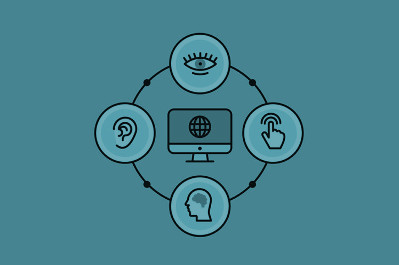The Internet is an ever-increasing storehouse of knowledge. The web and the internet as a whole serve as an important resource in many aspects of our lives: education, employment, recreation, commerce and more. Web Accessibility simply means that the web is to be made accessible to everyone. And that includes people with special abilities too – an aspect generally overlooked in haste.
The concept of Web Accessibility has been around for a decade, but it is unfortunate that true meaning in its entirety has been lost on many of us, the web developers. It’s time that we built ramps to our sites so that it benefits not only people with disabilities but also enhances the experience of all types of users as a whole.
……………………………………………………………………………………………………
Let’s see some examples: When you are watching a video in a noisy environment and cannot perceive the audio correctly. Without being able to hear the audio, you have to guess what the whole video is about. It can be frustrating, right?
Let’s take another one: If you have broken your arm in an accident and can’t use the mouse to explore the web. You have to remain cut off from the internet until you recover. Or find ways to manage to access it with difficulty, mostly through pain, or be at the mercy of people who would spare some time to assist you.
There are people out there who face these challenges at every instance of their attempts to access the Web. The true essence of Web Accessibility lies in addressing such concerns and ensuring that the Web is accessible by all, without any discretion.
The World Wide Web Consortium(W3C) published a set of guidelines, Web Content Accessibility Guidelines or WCAG 1.0 in 1999, as an initiative to the Web Accessibility Initiative(WAI) project. The revised version, WCAG 2.0 was published in 2008, which is more technology-neutral, and therefore, is widely accepted by the developers to make their site more accessible.
It may seem like a huge task to accomplish at first, but in reality, it takes only small steps to make your website accessible to all. Steps that should be undertaken are
- Using alternative texts, and descriptions for the images.
- Adding subtitles and transcripts for videos.
- Ensuring that your site is fully and equally accessible by the keyboard.
Making use of the Accessible Rich Internet Tags (ARIA) tags. - Having a good color contrast.
These are some tools which can help to make your website more accessible:
- WAVE by WebAIM
- Accessibility Developer Tools by Google Accessibility
- Some plugins like: WP Accessibility and Accessibility by Userway
So, let’s look at the bigger picture and start taking the necessary steps towards building a platform that is more accessible and more usable, and fulfill our responsibilities as web developers. It’s high time we focused on the masses who might be unable to access the internet just like normal people can. The onus lies with us to take individual responsibility of the same and spread the awareness to others. The realization that mere oversight or negligence on our part can be the source of much trouble for others should guard us against it.
……………………………………………………………………………………………………
The views and opinions expressed in this article are those of the author. To know more about our company, please click on Mindfire Solutions.
